AMD's 65nm Preview Part 2 - The Plot Thickens (Updated with Information from AMD)
by Anand Lal Shimpi on December 21, 2006 12:12 AM EST- Posted in
- CPUs
Gaming Performance & Power Usage
Quake 4 was the first application that really showed us the performance penalty you incur when moving to Brisbane, in this case the older core is about 4% faster. If you take into account that we're looking at performance at 1600 x 1200 with a GeForce 8800 GTX, in more GPU limited situations you're unlikely to notice the performance difference, but at more CPU limited situations the delta could likely grow even larger than 4%.
As the Core 2 processors are pushing much more data to the GPU than their competitors, average power consumption is generally much higher - it's the expense of greater performance in this case. The performance per watt charts take into account both factors and give you more of a breakdown of efficiency. Despite the decrease in performance, the reduction in power consumption gives the new Brisbane cores the efficiency advantage over most of their predecessors.
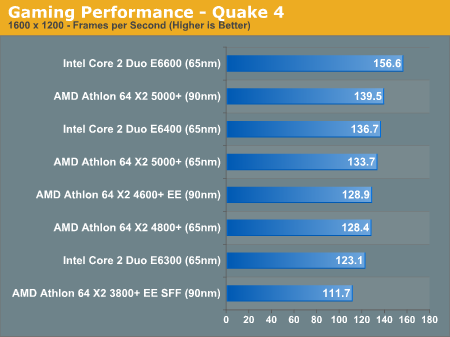

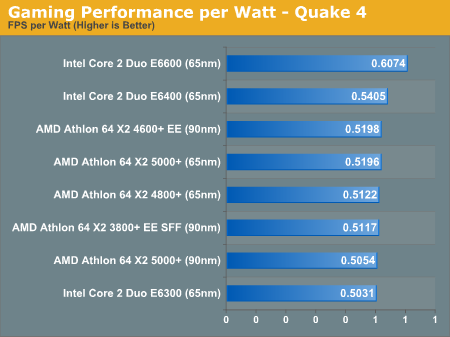
Oblivion didn't show a real impact in performance due to the slower Brisbane cores, but it clearly favors Intel's Core 2 architecture over AMD's.
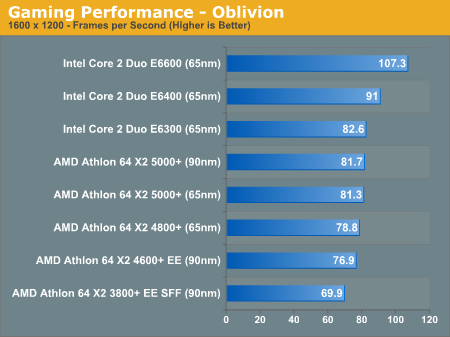
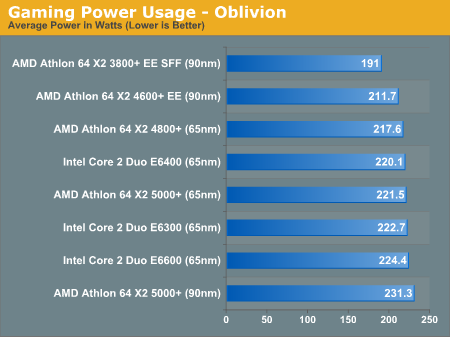
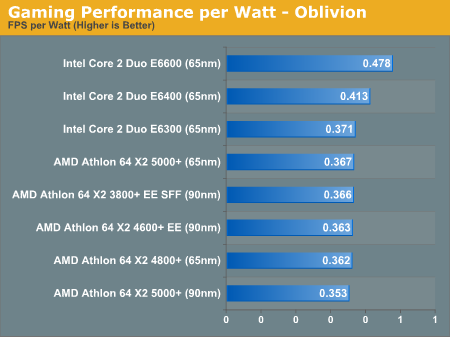










52 Comments
View All Comments
MartinT - Thursday, December 21, 2006 - link
AMD - Best CPU at doing nothing.This seems to be AMD's new mantra, no wonder given how hopelessly behind in performance and performance/Watt they are.
mino - Thursday, December 21, 2006 - link
Nicely said.Or better:
CPU using the least power while doing nothing...
DigitalFreak - Thursday, December 21, 2006 - link
LOLBeenthere - Thursday, December 21, 2006 - link
I doubt many PC enthusiasts place much importance on CPU power consumption. If they did Intel would never have sold any P4 chips. With Video cards drawing 200+ watts per card, a 65 nano AMD chip is a sweet piece.From my perspective, this is the first AMD 65 nano chips and like most process drops there is little performance gain just in lowering the nano size. AMD has a lot in the pipeline and as it arrives I suspect PC enthusiasts will be quite satisfied with both the CPU options and performance.
It should be pretty obvious that 99.9% of the market doesn't need faster CPUs, dual cores, quad cores, etc. until we get a decent O/S that can use these CPU features and full 64-bit function. How friggin long will we have to wait for quality 64-bit software to arrive? That is something that would help PC performance significantly, yet we've been waiting two years and the software folks have delivered almost nothing.
Sh0ckwave - Thursday, December 21, 2006 - link
You're right, enthusiasts don't care about power consumption at all. We care about performance and overclocking ability.The average user does not need a faster CPU.
Why doesn't Anandtech write articles for enthusiasts anymore?
mino - Thursday, December 21, 2006 - link
Also, many enthusiasts work at IT depts making decisions what architecture to go for.I mean, for 100s/1000s PCs deployment... An believe me, there, power IS taken into account.
Final Hamlet - Thursday, December 21, 2006 - link
Quote: I doubt many PC enthusiasts place much importance on CPU power consumption.If they did Intel would never have sold any P4 chips.
That is where you are wrong. Say it after me: Million-dollar-marketing-campaign.
Not the best product wins, but the best advertised.
Think back to P4-times: Some average I-know-that-I-have-to-press-the-big-button-to-make-my-compie-start-Joe would enter a big (online) store like DELL where his only choice was a P4 - end of selection.
Asked why he should buy it he would receive something like this: It has 3 REAL GHz, other manufacturers have _only_ about 2GHz. And then he would buy.
PS I'm no AMD-fanboy. One has to clearly admit that Intel did a marvellous job with it's Core2. Only reason to buy is aforementioned power consumption in idle (my PC is idle 90% of the time) und the nice low price.
Too strange. If you read hardware sites you could come to the conclusion that there are no single core CPUs anymore.
feelingshorter - Thursday, December 21, 2006 - link
Looking at those benchmarks, I think Intel won based on per/watt performance. AMD had lower watt usage but also lower performance. Given that a cpu can work harder, then be idle, i see per watt performance as the most important thing. I would have expected AMD to do better, but they did not come through.mino - Thursday, December 21, 2006 - link
No offense, but the moment one takes into account the fact of average PC spending >90% of time at idle, well, C2D eats X2's dust.From energy efficiency perspective, of course.
Accord99 - Thursday, December 21, 2006 - link
Only if the C2D gets paired with a hotter chipset. The P965 motherboards tend to use 10-20W less on idle and load.